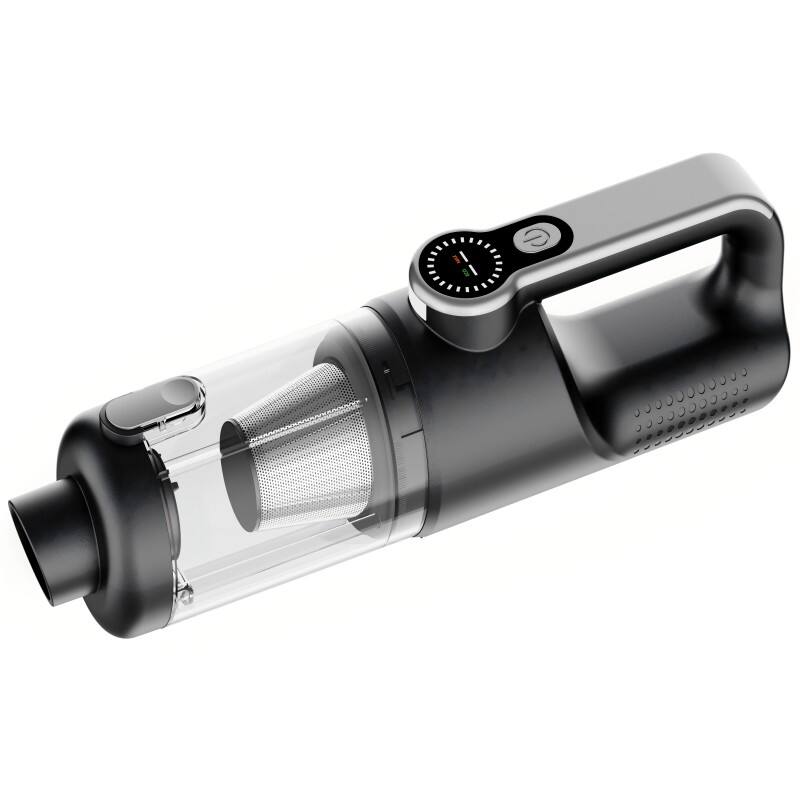Зөв дугуйн шахалт нь тээврийн хэрэгслийн аюулгүй байдал, шатахууны үр дүнтэй ашиглалт болон дугуйны үргэлжлэх хугацааны тулд маш чухал юм. Хамааралгүйгээр дугуй сойх боломжийг олгох найдвартай автомашины агаарын компрессор нь хөтөч бүрийн хувьд шаардлагатай хэрэгсэл болдог. Одоо үедээ гар утасны агаарын компрессорууд хэт их хөгжиж, урьдчилан тодорхойлсон шахалтын тохиргоо, тоон дэлгэц, илүү их цэнэг хадгалалт зэрэг дэвшилтэт онцлогуудыг санал болгож, дугуйн үйлчилгээний ажлыг илүү хялбар болгож өгсөн.

Тохиромжтой автомашины агаарын компрессор сонгохын тулд цахилгаан эх үүсвэр, шахалтын чадавх, зөөвөрлөх чадвар зэрэг олон хүчин зүйлсийг ойлгох шаардлагатай. Таны замын иргэний аврах тусламж хэрэгтэй эсвэл ердийн үйлчилгээний дэмжлэг шаардлагатай эс ямар ч байсан, гайхалтай компрессор нь таны тодорхой жолоочийн зан чанар, тээврийн хэрэгслийн шаардлагад нийцсэн байх ёстой. Энэхүү нэгэн дуусгасан заавар нь танд янз бүрийн төрлийн агаарын компрессоруудыг судлах, мөн таны автомашинтай холбоотой хэрэгцээнд хамгийн чухал шинж чанаруудыг тодорхойлоход туслах болно.
Машин заслын агаарын шахуургын янз бүрийн төрлүүдийг ойлгох
Гар дээрх цахилгаан шахуургууд
Гар дээрх цахилгаан шахуургууд нь хэрэглээнд тохиромжтой, ашиглахад хялбар тул хөдөлгөөнт тээврийн хэрэгсэл эзэмшигчдийн дунд хамгийн түгээмэл сонголт болдог. Эдгээр төхөөрөмжүүд ихэвчлэн таны машинд байгаа 12В-ын цахилгаан гаралтанд залгагдаж, хувийн автомашины дугуйнуудыг хангалттай шахах даралтыг өгдөг. Ихэнх цахилгаан загварууд нь илүүтэй шахалтаас сэргийлэх зориулалттай автоматаар зогсох функцтэй байдаг тул тов тавиад ашиглахыг хичээдэг жолоочидад илүү тохиромжтой.
Гар дээрх цахилгаан шахуургын эвгүйрэг бага хэмжээ нь тэдгээрийг машинийн ачааны хайрцаг эсвэл цоорхой хайрцагт хадгалахад хялбар болгодог. Олон загварууд нь шөнийн цагт ашиглах зориулалттай доторх LED гэрэлтүүдийг багтаасан бөгөөд спортын тоног төхөөрөмж, велосипедний дугуй, бусад хийж хийх зүйлсийг хийж дүүргэхэд зориулсан олон төрлийн сүүлтэй холболтуудтай ирдэг. Цахилгаан загвар сонгохдоо бүх дөрвөн дугуй хүртэл амархан хүрч чадахуйцаар утасны уртыг авч үзэх хэрэгтэй.
Баттерейтэй шахуургууд
Цахилгаан батерейтэй машин засварын насос нь хөдөлгүүрт тээврийн хэрэгслээс үл хамаарах, гарт чиний авч явахад тохиромжтой шийдэл санал болгодог. Эдгээр утасгүй загварууд нэг удаагийн цэнэглэлтээр хэд хэдэн удаа дугуйны шороо цохих боломжийг олгодог цэнэглэж ашигладаг лити-ион батерейтэй байдаг. Дэвшилтэт цахилгаан батерейт насоснууд нь зорилтот даралтанд хүрэх үед автоматаар зогсох умайлаг урьдчилан тохируулгатай ирдэг тул даралтыг таамаглах шаардлагагүй болгох ба шороог гэмтээхээс сэргийлдэг.
Цахилгаан батерейт насосны гол давуу тал нь олон талт ашиглах боломж ба яаралдай тусламжийн бэлэн байдлын хангамж юм. Та үүнийг машинаас хол байх үед ашиглаж болох тул аялалд явж байхад велосипедний шороо, спортын бөмбөг эсвэл агаарын матрац цохихад илүү тохиромжтой. Цахилгаан батерейт загваруудыг үнэлэхдээ батерейн багтаамж, цэнэглэх хугацаа болон нэг цэнэглэлтээр хийх боломжит шорооны цохилтын тоог анхаарч, таны хэрэгцээнд нийцэхийг хангана уу.
Анхаарах зүйлс: Үйл ажиллагааны чухал онцлог
Даралтын гаралт ба урсгалын хурд
Даралтын гаралтын чадал нь машин засварлах шахуурга таны тодорхой шаардлага бүхий дугуйг үр дүнтэй ажиллуулах эсэхийг тодорхойлно. Ихэнх хувийн автомашин 30-35 PSI-ийн даралт шаарддаг бол, том SUV ба ачих машины хувьд 80 PSI ба түүнээс дээш шаардлагатай байдаг. Хамгийн их даралтын шаардлагатайгаас хамгийн багадаа 20%-иар илүү байх шахуургыг сонгоно уу. Ингэснээр илүү сайн ажиллагаа болон хурдан цохих хугацааг хангана.
Куб метр/минут эсвэл литр/минутаар хэмжигдэх урсгалын хурд нь шахуурга таны дугуйг хэр хурдан цохиж чадахыг харуулна. Өндөр урсгалын хурд нь цохих хугацааг богиносгох бөгөөд ялангуяа яаралтай тусламж шаардлагатай үед эсвэл бүрэн хагарсан дугуйтай тулгарах үед маш чухал болдог. Мэргэжлийн түвшний шахуургууд ерөнхийдөө минутанд 30 литрээс дээш урсгалын хурдтай байдаг бол, жижиг загварууд стандарт ашиглаачидад зориулан минутанд 15-25 литрийн хооронд урсгал өгдөг.
Цахим хяналт ба ухаалаг онцлог
Орчин үеийн автомашины агаарын шахуургын загварууд нь хэрэглэгчийн туршлагыг сайжруулах, элбэлзэхтэй холбоотой тохиолддог алдаануудыг урьдчилан сэргийлэх зориулалттай мэдрэг дижитал удирдлагаар хангагддаг. Урьдчилан тогтоосон даралтын функц нь таны шаардсан даралтын түвшнийг онооход боломжийг олгох бөгөөд шахуурга шаардлагатай PSI-д хүрэх үед автоматаар зогсоно. Том дижитал дэлгэц нь бодит цагт даралтын хэмжээг харуулж, явцыг хянах, нарийвчлалтай агааржуулахыг хангахад хялбар болгодог.
Санах ойн тохиргоо шиг ухаалаг онцлог нь янз бүрийн машин эсвэл дугуйн төрлүүдэд ихэвчлэн ашигладаг даралтын түвшнийг хадгалж чаддаг. Зарим дэвшилтэт загварууд ухаалаг утасны холболттой байдаг тул та агааржуулах явцыг алсаас хянах эсвэл үйл явц дуусах үед мэдэгдэл хүлээн авах боломжтой. Эдгээр технологийн сайжруулалтууд нь жижиг засвар үйлчилгээний энгийн ажлыг цаг хэмнэх, буруу агааржуулах эрсдэлийг бууруулах, алдаагүй, хялбаршуулсан процесст шилжүүлдэг.
Хүчний эх үүсвэр ба зөөврийн боломжийн авч үзэлт
12V Хүчний холболтын сонголтууд
Уламжлалт 12V-ийн машин зогсох шатны агаарын шахуургууд нь таны машины тамхины утааны чийдэн эсвэл цахилгааны гаралтанд шууд холбогдож, генератор эсвэл баттерейнаас цахилгаан хангамжийг авдаг. Энэ холболтын арга нь урт хугацааны ажиллагааны турш тогтмол цахилгаан хангамжийг хангаж, том хэмжээний дугуй эсвэл олон машин дүүргэхэд тохиромжтой болгодог. Гэсэн хэдий ч ашиглах үед утасны урт болон цахилгааны гаралтын байршил нь байрлуулах боломжийг хязгаарладаг.
12V-ээр ажилладаг шахуургуудыг сонгохдоо таны машины цахилгааны гаралт нь төхөөрөмжийн амперийн шаардлагыг хэтрүүлэхгүйгээр даах чадвартай эсэхийг шалгана уу. Зарим өндөр үзүүлэлттэй загварууд нь хамгийн сайн цахилгаан хангамжийг хангахын тулд шууд баттерей руу крокодил хавхлагаар холбогдох шаардлагатай байдаг. Машин таньг зөөлгүйгээр бүх дугуйн байрлалд хүрэхийн тулд маш урт цахилгааны утас эсвэл нэмэлт утас бүхий загваруудыг авч үзнэ үү.
Цэнэглэдэг Цахилгаан Багтаамж
Орчин үеийн автомашины агаар шахуургын нэгжид цэнэглэх боломжтой баттерейн систем нь хэт их зохион байгуулалт, аварга тохиолдолд бэлэн байдалт чухал давуу талыг олгоно. Их багтаамжтай лити-ион баттерей нь ихэвчлэн дугуйн хэмжээ, эхний даралтаас хамааран цэнэглэлтэд 4-6 удаа дугуй хийх боломжийг олгоно. Маш урт цахилгаан баттерейн загварууд нь 10 ба түүнээс дээш удаа хий шахах боломжийг олгох бөгөөд флотын үйлчилгээ үзүүлэгчид эсвэл байнга аялагчдын хувьд илүү тохиромжтой.
Цахилгаан баттерейтэй шахуургууд нь таны машин, машины баттерей нас барсан эсвэл инженгийг асаалгүйгээр зогсож буй машины ажиллагаанд хамаарлыг арилгана. Чухал мөчид цахилгаан хангамжгүй шахуургатай болохоос сэргийлэхийн тулд USB-ээр цэнэглэх боломж, баттерейн түвшний заагчтай загваруудыг хайна уу. Зарим анги дээд чанартай нэгжүүд нь хамгийн их олон талт байдлыг хангахын тулд баттерейн цахилгаан ба 12В-ийн холболтын хоёр хэрэгслийг агуулдаг.
Шаардлагатай нэмэлт хэрэгслүүд ба холбох төхөөрөмж
Хий шахах нумнууд ба зохицуулагчид
Автомашиний хөргөгчийн бүрэн багц нь автомашины дугуйгаас гадна олон төрлийн хий шахах ажилд зориулсан олон тооны сүвний хавтангуудыг агуулсан байх ёстой. Стандарт багцууд нь автомашины дугуйн хувьд Шрэдэр вентилийн хавтангууд, замын дугуйн хувьд Преста вентилийн залгаварууд, спортын бөмбөг болон хийж хөргөх тоглоомын хувьд зориулсан зүүний хавтангуудыг агуулдаг. Мэргэжлийн түвшний багцуудад мотоциклын дугуй, АВ-ийн хэрэглээ, худалдааны тээврийн хэрэгслийн системийн тусгай сүлбэсэн хавтангууд орж болно.
Чанартай хавтангууд нь ажиллагааны үеэр хий алдалтаас сэргийлэх, тогтмол даралттай хангамжийг хангах зорилгоор баталгаатай түгжих механизмийг ашигладаг. Хурдан холбогчийн хэсгүүд нь хавтанг солих үед цаг хэмнэх, замын иргэдийн яаралтай тусламжийн үед жижиг хэсгүүдийг алдах эрсдэлийг бууруулдаг. Хөргөгчийн багцыг үнэлэхдээ бүх хавтангуудыг дахин дахин ашиглахад чангарч, үйлчилгээний чанар буурах эсвэл хий алдахгүй байх тэсвэртэй материалуудаас хийгдсэн эсэхийг шалгана уу.
Хадгалалт, Зохицуулалтын Бодлогууд
Үр дүнтэй хадгалах шийдэл нь таны автомашины агаарын компрессор болон хавтангуудыг зохион байгуулж, тээвэрлэлтийн үеэр деталуудыг гэмтлээс хамгаалдаг. Олон дэвшилтэт загварууд нь гол төхөөрөмж, цахилгаан кабель, олон төрлийн холболтуудын тусгай хэсгүүдийг багтаасан онцгой тохируулсан зүүлтэй ирдэг. тухай хатуу хайрцаг нь механик гэмтэл болон чийгнээс илүү сайн хамгаалалт үзүүлдэг бол зөөлөн сумка нь хөнгөн жинтэй, хадгалалтын илүү уян хатан сонголтуудыг санал болгодог.
Утасны ороош, хавтангийн барих төхөөрөмжийг дотор нь багтаасан барилгын дотоод хадгалалтын онцлог нь тусдаа хадгалах сав баглаа боодол шаардлагагүй болгох ба ашиглах үед суурилуулах хугацааг багасгадаг. Зарим компрессорууд ажиллагааны үед металл гадаргууд бэхлэх соронзон суурь эсвэл бэхлэх түлхүүрүүдтэй байдаг бөгөөд хөдөлгөөн, хэвийн бус хэлбэлзэл үүсэхээс сэргийлдэг тул машины деталуудад гэмтэл учруулах, ажиллагаанд нөлөөлөх боломжийг бууруулдаг.
Ажиллагааны тестлэлт болон найдвартай байдал
Нарийвчлал болон калибрлалтын стандартууд
Даралтын нарийвчлал нь шидэний ажиллагаанд, түлшний үр дүнтэй ашиглалтанд болон аюулгүй байдлын хувьд шууд нөлөөлдөг тул тавих стандартыг сонгохдоо энэ нь чухал хэрэг. автомашины агаарын шингөтгөгч мэргэжлийн түвшний багажууд нь ихэвчлэн ажиллах хязгаарт ±1 PSI-ийн нарийвчлалыг хадгалдаг бол зөрөөтэй загварууд нь ±3 PSI эсвэл түүнээс дээш хазайлттай байж болно. Урт хугацааны нарийвчлалыг хадгалахын тулд тавих стандартыг зааж өгсөн, дахин тавих үйлчилгээ үзүүлдэг шахуургыг сонгоно уу.
Температурын хувьд өөр өөр нөхцөлд цифрийн даралт хэмжигч нь ерөнхийдөө аналог хэмжигчид илүү тогтвортой унших хэмжээг өгдөг. Зарим дэвшилтэт загварууд орчны нөхцөлд тохируулан унших хэмжээг засдаг автоматаар температурт тохируулагчийг агуулдаг бөгөөд цаг агаар, улирлын өөрчлөлтөөс үл хамааран нарийн хэмжилтийг хангана. Тусдаа тавьсан, калибракцийн хэмжигч ашиглан нарийвчлалыг үе үе шалгах нь дахин тавих эсвэл солих шаардлагатай болсон үед илрүүлэхэд тусална.
Өргөн эдэлгээтэй ба барилгын чанартай
Барилгын чанар нь машин засварлах агаарын шахуурга хэвийн ашиглалт, температурын хязгаар, аварга тохиолдлын үед эсвэл хэтэрхий их ачаалалд хэрхэн тэсвэртэй байхыг тодорхойлдог. Хүнд даацын загваруудад металл хальс, бэхэлгээний бат бөх цэгүүд болон коррозид өртөх, механик стрессээс хамгаалах зориулалттай үйлдвэрийн стандартын цахилгаан холболтууд агуулагддаг. Хэрэглээний түвшний төхөөрөмжүүд нь жин болон өртгийг бууруулахын тулд хангалттай нарийн чанар бүхий пластик материалыг ашигладаг.
Цахилгаан моторын загварчлал нь ажиллах хугацаанд илүү ихээр нөлөөлдөг бөгөөд зөөврийн хэрэгслүүдэд ременный дамжуулгатай системүүдтэй харьцуулахад шууд дамжуулгатай системүүд илүү найдвартай байдаг. Дулаан хамгаалалтын систем нь урт хугацаагаар ашиглах үед хэт халалтаас сэргийлдэг бөгөөд битүү хаалттай дээлсэн болон коррозоос хамгаалагдсан деталиуд орчин үеийн ялгаатай нөхцөл байдлаас хамаарч тогтвортой ажиллагааг хангана. Барилгын чанарыг үнэлэхдээ хариуцлагын хугацаа болон үйлдвэрлэгчийн нэр хүндийг хүлээгдэж буй найдвартай ажиллагаа болон техникийн дэмжлэгийн заагчид гэж үзэх хэрэгтэй.
Аюулгүй байдлын онцлог шинжүүд ба хэрэглэгчийн хамгаалалт
Автоматаар Зогсох Системүүд
Автоматаар зогсох үйлдэл нь орчин үеийн автомашины агаар шахуургын загварчлал дахь хамгийн чухал аюулгүй байдлын шинж чанаруудын нэг юм. Эдгээр системүүд нь лацтай агааржуулах үеийн турш тасралтгүйгоор лацны даралтыг хянах бөгөөд урьдчилан тохируулсан зорилтот түвшинд хүрэх үед автоматаар ажиллагааг зогсоодог. Энэ нь лацны гэмтэл, лац эвдэрэх эсвэл ажиллуулагчид гэмтэл учруулах аюултай их даралт үүсэхээс сэргийлдэг.
Дэвшилтэт зогсолтын системүүд нь хэт хугацааны ашиглалт үеэр хөдөлгүүрийн гэмтлийг сэргийлэх зориулалттай дулааны давхар ачааллын хамгаалалт, системийн илүүдэл даралтаас хамгаалах зориулалттай даралт бууруулах вентиль гэх мэт олон хамгаалалтын горимыг агуулдаг. Зарим загварууд нь зорилтот даралтанд ойртох үед хэрэглэгчдийг мэдээлэх дууны болон харааны дохиосон дохионыг агуулдаг бөгөөд хэрэгтэй бол гарын авлагаар тусгайлан засварлах боломжийг олгодог ч автоматаар хамгаалах нөөцийн хамгаалалтыг хадгалж байдаг.
Ажиллагааны Аюулгүй Байдалд Анхаарах Зүйлс
Зөв ажиллагааны аюулгүй байдал нь автоматашсан онцлогуудаас хэтэрч, хэвийн ашиглалтын үед хэрэглэгчдийг хамгаалах зориулалттай загварын элементүүдийг багтаадаг. Гараа таталтгүй суурь ба хүний биеийн жиших хэмжээнд нийцсэн барьж барих цэг нь ашиглах үедээ найдвартай барьж барих болон тогтвортой байрлалыг хангахад тусалдаг бол интеграцичлагдсан LED ажлын гэрэл нь шөнийн болон бага гэрлийн нөхцөлд харагдах чадварыг сайжруулдаг. Халуун гадаргуугаас шалтгаалсан шархлаас сэргийлэхийн тулд дулаан тэсвэртэй материал болон тохиромжтой агааржуулалтыг урт хугацааны ажиллалтын дараа хэрэглэдэг.
Цахилгааны аюулгүй байдлын онцлогуудад машины цахилгаан системийн доголдолоос гарах эвдрэлийг сэргийлэх зориулалттай зөв газаршуулсан холболтууд, предохранительтэй цахилгаан кабелууд болон цахилгаан схемүүд орно. Чанартай загварууд нь кабелийг гэмтэлээс хамгаалах, найдвартай цахилгаан холболттой байлгахын тулд холболтын цэгт дааруулах хүчийг багасгах шийдлийг агуулдаг. Цахилгаан бүрэлдэхүүн хэсгүүд холбогдох аюулгүй байдлын стандартыг хангаж, автомашинд зориулсан тохиромжтой сертификатыг агуулж байгаа эсэхийг үргэлж шалгана уу.
Түгээмэл асуулт
Машинны агаарын компрессор-д ямар PSI чадавхитай байх ёстой вэ
Ихэнх хувийн тээврийн хэрэгслүүдэд 30-35 PSI шаардлагатай боловч, ажиллагааны аюулгүй байдлын заагийг хангалттай байлгах, хурдан агааржуулах боломжийг олгохын тулд дор хаяж 100-150 PSI чадал бүхий шахуургыг сонгоно. Илүү өндөр PSI-ийн чадал нь стандарт хувийн тээврийн хэрэгслийн тоосгоноос илүү даралт шаардагдах том хэмжээний тээврийн хэрэгслүүд, ачааны машин эсвэл тусгай зориулалтын ашиглалтанд ашиглах боломжийг олгоно.
Чанартай автомашины агаар шахуурга энгийн ашиглалтанд хэр удаан үлдэх ёстой вэ
Сайн барьсан автомашины агаар шахуурга нь тоосгоны үйлчилгээний үед сард нэг удаа ашиглахад найдвартайгаар 3-5 жил ажиллах ёстой. Чанартай мотор, бүтэцтэй хүнд даацын загварууд 7-10 жил эсвэл түүнээс илүү хугацаагаар үлдэж болно. Баттерейтэй нэгжүүд нь ихэвчлэн 2-3 жилийн дараа баттерей солих шаардлагатай байдаг ч, шахуургын механизм өөрөө тэр хугацаанаас хамаагүй илүү урт хугацаанд сайн ажиллах ёстой.
Тоосгоны гадуурх агааржуулах шаардлагад автомашины агаар шахуургыг ашиглаж болох уу
Тийм, ихэнх автомашины агаар шахуургын загварууд нь велосипед, спортын тоног төхөөрөмж, агаартай матрац, бассейны тоглоомжуудыг хийтэй дүүргэхэд зориулсан олон хавтангуудыг агуулдаг. Гэхдээ шахуургын даралтын муж болон урсгалын хурд таны зориулалтад тохирч байгааг шалгана уу. Зарим мэдрэмтгий зүйлс нь авто машины хэрэглээнээс илүү бага даралт шаарддаг тул сонгосон загвар нь нарийвчлалтай даралт шигшээрийг санал болгодог эсэхийг итгэлтэй байна уу.
Автомашины агаар шахуурга ямар үйлдвэрийн үйлчилгээтэй байдаг вэ
Энгийн үйлчилгээний үед агаарын шүүлтүүрийг цэвэр байлгах, цахилгаан холболтуудыг идэвхжилтээс шалгах, жилд нэг удаа даралтын заагчийн нарийвчлалыг шалгах орно. Цахилгаан баттерейтэй загваруудад үе үе баттерейг нөхөн сэргээх шаардлагатай бөгөөд эцэст нь солих шаардлагатай болно. Шахуургыг хуурай орчинд хадгалж, ажиллагааны үеийн үр ашгийг эсвэл аюулгүй байдлыг хэрхэн нөлөөлөх боломжтой хоолой, хавтангуудыг элэгдэл, гэмтэлд шалгана уу.
Гарчиг
- Машин заслын агаарын шахуургын янз бүрийн төрлүүдийг ойлгох
- Анхаарах зүйлс: Үйл ажиллагааны чухал онцлог
- Хүчний эх үүсвэр ба зөөврийн боломжийн авч үзэлт
- Шаардлагатай нэмэлт хэрэгслүүд ба холбох төхөөрөмж
- Ажиллагааны тестлэлт болон найдвартай байдал
- Аюулгүй байдлын онцлог шинжүүд ба хэрэглэгчийн хамгаалалт
- Түгээмэл асуулт

